Potrebujeme váš súhlas na využitie jednotlivých dát, aby sa vám okrem iného mohli ukazovať informácie týkajúce sa vašich záujmov. Súhlas udelíte kliknutím na tlačidlo „OK“.
ASTM D7137/D7137M-12
Standard Test Method for Compressive Residual Strength Properties of Damaged Polymer Matrix Composite Plates
Automaticky preložený názov:
Štandardná skúšobná metóda pre zvyškové tlakové pevnostné vlastnosti poškodených Polymer Matrix Kompozitné dosky
NORMA vydaná dňa 1.4.2012
Informácie o norme:
Označenie normy: ASTM D7137/D7137M-12
Poznámka: NEPLATNÁ
Dátum vydania normy: 1.4.2012
Kód tovaru: NS-37647
Počet strán: 16
Približná hmotnosť: 48 g (0.11 libier)
Krajina: Americká technická norma
Kategória: Technické normy ASTM
Kategórie - podobné normy:
Anotácia textu normy ASTM D7137/D7137M-12 :
Keywords:
composite materials, compression after impact, compression testing, compressive residual strength, damage tolerance, Composite materials, Compression testing, Compressive residual strength, Damage tolerance, ICS Number Code 83.120 (Reinforced plastics)
Doplňujúce informácie
| Significance and Use | ||||||||||||||||||||||||||||||||||
|
Susceptibility to damage from concentrated out-of-plane forces is one of the major design concerns of many structures made of advanced composite laminates. Knowledge of the damage resistance and damage tolerance properties of a laminated composite plate is useful for product development and material selection. The residual strength data obtained using this test method is most commonly used in material specifications and research and development activities. The data are not intended for use in establishing design allowables, as the results are specific to the geometry and physical conditions tested and are generally not scalable to other configurations. Its usefulness in establishing quality assurance requirements is also limited, due to the inherent variability of induced damage, as well as the dependency of damage tolerance response upon the pre-existent damage state. The properties obtained using this test method can provide guidance in regard to the anticipated damage tolerance capability of composite structures of similar material, thickness, stacking sequence, and so forth. However, it must be understood that the damage tolerance of a composite structure is highly dependent upon several factors including geometry, stiffness, support conditions, and so forth. Significant differences in the relationships between the existent damage state and the residual compressive strength can result due to differences in these parameters. For example, residual strength and stiffness properties obtained using this test method would more likely reflect the damage tolerance characteristics of an un-stiffened monolithic skin or web than that of a skin attached to substructure which resists out-of-plane deformation. Similarly, test specimen properties would be expected to be similar to those of a panel with equivalent length and width dimensions, in comparison to those of a panel significantly larger than the test specimen. The reporting section requires items that tend to influence residual compressive strength to be reported; these include the following: material, methods of material fabrication, accuracy of lay-up orientation, laminate stacking sequence and overall thickness, specimen geometry, specimen preparation, specimen conditioning, environment of testing, void content, volume percent reinforcement, type, size and location of damage (including method of non-destructive inspection), specimen/fixture alignment and gripping, time at temperature, and speed of testing. Properties that result from the residual strength assessment include the following: compressive residual strength FCAI, compressive force as a function of crosshead displacement, and surface strains as functions of crosshead displacement. |
||||||||||||||||||||||||||||||||||
| 1. Scope | ||||||||||||||||||||||||||||||||||
|
1.1 This test method covers compression residual strength properties of multidirectional polymer matrix composite laminated plates, which have been subjected to quasi-static indentation per Test Method D6264/D6264M or drop-weight impact per Test Method D7136/D7136M prior to application of compressive force. The composite material forms are limited to continuous-fiber reinforced polymer matrix composites with multidirectional fiber orientations, and which are both symmetric and balanced with respect to the test direction. The range of acceptable test laminates and thicknesses is defined in 8.2. Note 1—When used to determine the residual strength of drop-weight impacted plates, this test method is commonly referred to as the Compression After Impact, or CAI, method. 1.2 The method utilizes a flat, rectangular composite plate, previously subjected to a damaging event, which is tested under compressive loading using a stabilization fixture. Note 2—The damage tolerance properties obtained are particular to the type, geometry and location of damage inflicted upon the plate. 1.3 The properties generated by this test method are highly dependent upon several factors, which include specimen geometry, layup, damage type, damage size, damage location, and boundary conditions. Thus, results are generally not scalable to other configurations, and are particular to the combination of geometric and physical conditions tested. 1.4 This test method can be used to test undamaged polymer matrix composite plates, but historically such tests have demonstrated a relatively high incidence of undesirable failure modes (such as end crushing). Test Method D6641/D6641M is recommended for obtaining compressive properties of undamaged polymer matrix composites. 1.5 The values stated in either SI units or inch-pound units are to be regarded separately as standard. The values stated in each system may not be exact equivalents; therefore, each system shall be used independently of the other. Combining values from the two systems may result in non-conformance with the standard. 1.5.1 Within the text the inch-pound units are shown in brackets. 1.6 This standard does not purport to address all of the safety concerns, if any, associated with its use. It is the responsibility of the user of this standard to establish appropriate safety and health practices and determine the applicability of regulatory limitations prior to use. |
||||||||||||||||||||||||||||||||||
| 2. Referenced Documents | ||||||||||||||||||||||||||||||||||
|
Podobné normy:
Historická
1.3.2011
Historická
1.9.2011
Historická
15.11.2011
Historická
1.5.2013
Historická
1.9.2007
Historická
1.7.2012



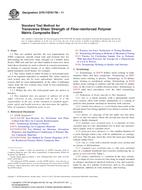 ASTM D7617/D7617M-11..
ASTM D7617/D7617M-11..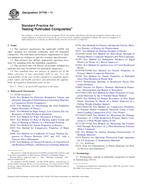 ASTM D7745-11
ASTM D7745-11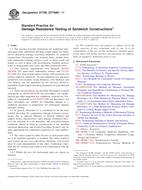 ASTM D7766/D7766M-11..
ASTM D7766/D7766M-11..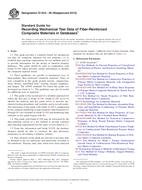 ASTM E1434-00(2013)..
ASTM E1434-00(2013)..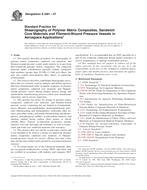 ASTM E2581-07
ASTM E2581-07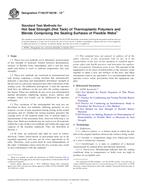 ASTM F1921/F1921M-12..
ASTM F1921/F1921M-12..
 Cookies
Cookies
